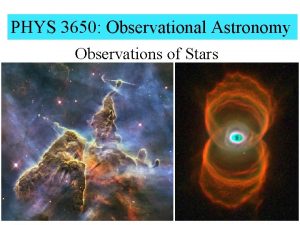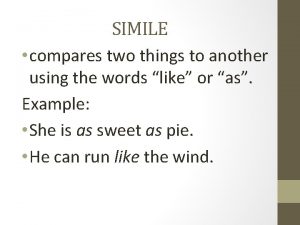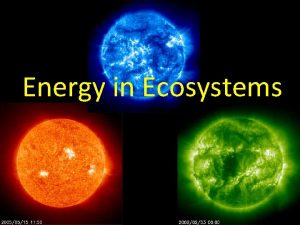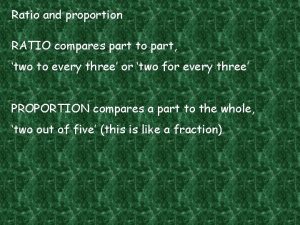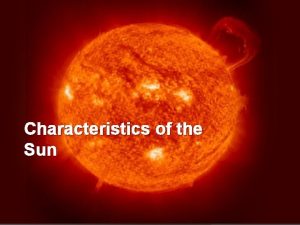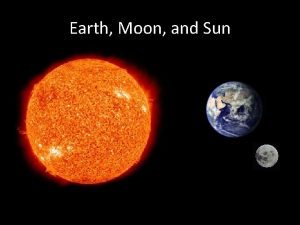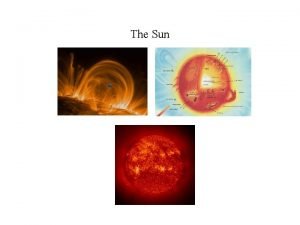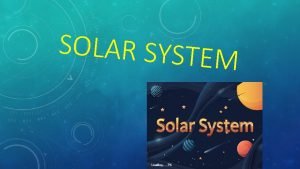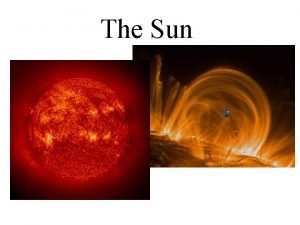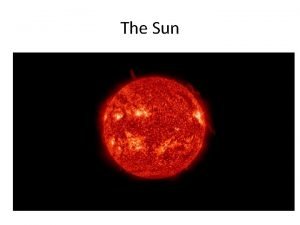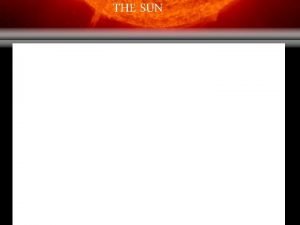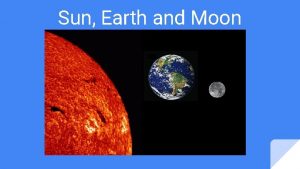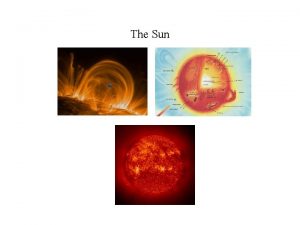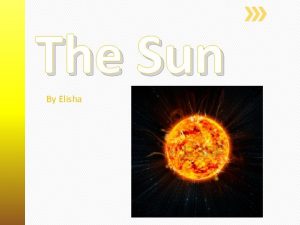The Sun Characteristics How it compares to other













- Slides: 13

The Sun • Characteristics • How it compares to other stars • How we have studied it • It’s evolution history • It’s projected future

Characteristics §The sun is actually a medium sized star. it only appears larger because it is so close to the earth. §The distance from earth to the sun varies from 91, 377, 000 miles to 94, 537, 000 miles. §Its diameter is approximately 865, 400 miles. §The suns average density is 1. 41. §It has a temperature of about 10 to 20 million degrees Celsius & a pressure of I billion atmospheres.

Properties of the Sun § § The suns volume can hold over one million earths. A particle traveling at the speed of light takes 8 minutes and 20 seconds to travel between the sun and earth. Its mass is 745 times greater than all the planets together. The suns interior temperature is as high as 15, 000 degrees Celsius.

How the Sun Compares to Other Stars sun star

How the Sun Compares to Stars… § The smallest stars can be smaller than the earth, but the largest stars can be over 2, 000 times the diameter of the sun. § The sun’s temperature is about 5, 500 degrees Celsius. Stars that are blue, have a temperature of approximately 30, 00 degrees Celsius. Red stars’ temperatures are

How the Sun Compares to Stars… §Betelgeuse is one tenmillionth as dense as the sun §Betelgeuse is red, the sun is yellow, and Sirius is blue. Blue is hotter in temperature and red is cooler.

How the Sun has been Studied Early Chinese astronomers studied the sun while it was red and dim during sunset and sunrise. Galileo studied the sun with a telescope and his eyes, which in his later years caused him to become blind. In 1859, astronomers used a spectroscope and were able to prove that lines in the suns spectra were connected to specific chemical elements.

How the sun has been studied A solar telescope had been designed to view the sun in a safer way. It projects a large image of the sun into a dark room underground. With special glasses, astronomers can observe the sun and its changes. Satellites are used to observe the sun without interfering with the Earth.

The suns evolution history

The sun’s evolution history ¡ Started with an advancing contraction of gas by self-gravitation, which sometimes can be interrupted by thermonuclear burning. After certain types of nuclear fuel (hydrogen, helium) are exhausted, the contraction-burning cycle will start over with higher temperatures. The sun’s evolution stages are from primitive solar nebula contraction to the black dwarf stage. The sun spent a major part of it’s life in the main sequence. Then it went to the movement of the black-dwarf evolution stage, which is the final stage in it’s evolution.

The suns projected future ¡ The sun is said to last for about another 5 billion years. ¡ In about 250 million years the sun will grow 100 times larger and 500 times more luminous.

The sun’s projected future • Eventually, the suns hydrogen resources with be used up. • The fusion energy will no longer inflate the sun. • Gravity will compress the sun’s core. • After the fusion reaction has changed the hydrogen to helium, the pressure will then start nuclear reaction of helium. • Now, the sun will change into a red giant. • The sun will only remain a red giant for approximately 700 million years. • Finally, the interior of the sun will contract into a white dwarf about the size of earth and then cool down to a black dwarf. This will be the end of the sun.

Interactive websites ¡ click here to see the how the sun and other stars evolve ¡ click here to watch the animation of the sun within the last 48 hours
 How big is the sun compared to other stars
How big is the sun compared to other stars Self initiated other repair examples
Self initiated other repair examples Understanding ratios
Understanding ratios A comparison between two things using like or as
A comparison between two things using like or as Figurative language comparing two things
Figurative language comparing two things Blue jay trophic level
Blue jay trophic level A percent is a ratio that compares a number to
A percent is a ratio that compares a number to 9 out of 10 dentists recommend
9 out of 10 dentists recommend Is sonnet 18 iambic pentameter
Is sonnet 18 iambic pentameter One ratio compares a part to a whole
One ratio compares a part to a whole As the load on an engine increases the manifold
As the load on an engine increases the manifold A typical map compares the vacuum in the intake manifold to
A typical map compares the vacuum in the intake manifold to Compare 2 people
Compare 2 people Is a ratio a rate
Is a ratio a rate
